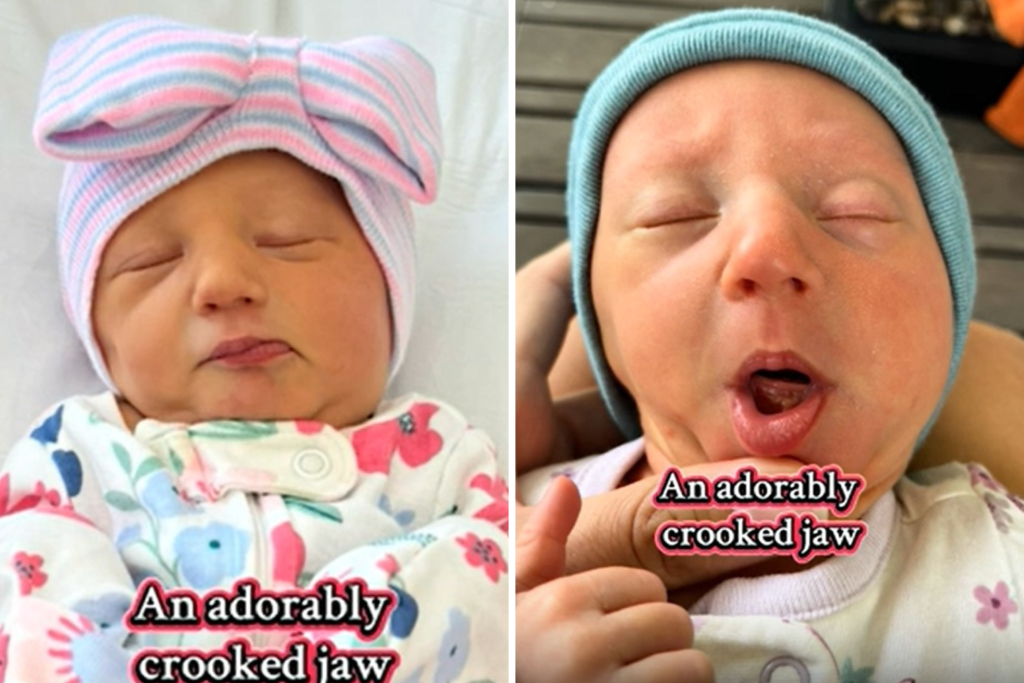This viral TikTok video, shared by Taylor Deal, a labor and delivery nurse and mother of twins, documents the journey of her daughter’s “crooked jaw,” a condition attributed to the intrauterine pressure exerted by her twin sibling. The video, which garnered millions of views, showcases a series of images depicting the daughter’s jaw asymmetry from birth to its eventual correction. Deal’s initial concern and worry, stemming from the lack of definitive answers from medical professionals regarding the condition’s permanence, is palpable throughout the video’s narrative. This uncertainty fueled her anxiety about potential feeding difficulties and the possibility of future corrective surgery. While the video highlights the visible impact of the twin’s position in utero, it also underscores a mother’s natural apprehension when faced with an unknown health issue affecting her child.
Deal’s proactive approach to addressing her daughter’s jaw asymmetry involved exploring alternative therapies like craniosacral massage therapy and chiropractic adjustments. These gentle techniques, aimed at releasing tension in the skull and surrounding muscles, were incorporated into the care regimen. While she credits time as the ultimate healer, the combined approach may have contributed to the positive outcome. The video’s success lies in its relatable portrayal of a common parental fear – witnessing a physical anomaly in their child and grappling with the uncertainty surrounding it. It offers a glimpse into the emotional rollercoaster experienced by parents navigating such situations, while also showcasing the resilience of both mother and child.
The video’s resonance with viewers is evident in the outpouring of comments and shared experiences, many echoing similar situations with twins or siblings experiencing temporary physical alterations due to intrauterine positioning. This collective sharing of anecdotal evidence not only validates Deal’s experience but also provides a sense of community and reassurance to other parents facing similar anxieties. It reinforces the idea that such occurrences are not entirely uncommon and often resolve naturally with time. The video inadvertently creates a platform for open conversation about the less-discussed aspects of multiple pregnancies and their potential impact on fetal development.
Gareth Nye, a lecturer in medical science specializing in maternal and fetal health, provides an expert perspective on the video’s subject matter. He postulates that while the twin’s position likely exacerbated a pre-existing minor skull or jaw malformation, such alterations often resolve spontaneously over time. Nye’s explanation emphasizes the importance of distinguishing between temporary positional effects and underlying developmental issues. He highlights the need for ongoing assessment to monitor the child’s growth and development, especially in cases where feeding and breathing are unaffected. This expert commentary adds a layer of scientific understanding to the discussion, reassuring viewers while emphasizing the necessity of medical evaluation for any concerns.
The video’s narrative arc, from initial concern and uncertainty to eventual resolution, underscores the power of observation, patience, and seeking appropriate care. While Deal’s initial fears were understandable given the visible asymmetry, the eventual correction highlights the remarkable capacity of the human body to self-correct, especially in early childhood. This aspect of the video offers a hopeful message to parents facing similar situations, urging them to trust the natural healing process while remaining vigilant about any persistent or concerning symptoms. It also emphasizes the importance of seeking expert medical advice when necessary, ensuring informed decisions are made regarding the child’s well-being.
The video serves as a valuable case study, sparking broader discussion about the complexities of multiple pregnancies and their potential impact on fetal development. It offers a glimpse into the unique challenges and joys associated with raising twins, while also highlighting the resilience of both parents and children in navigating unforeseen health concerns. The viral nature of the video reflects its relatability and the universality of parental anxieties, fostering a sense of community among viewers who share similar experiences. It also underscores the power of social media platforms in disseminating information and facilitating open conversations about often overlooked aspects of pregnancy and childbirth.










